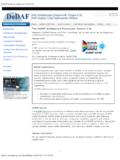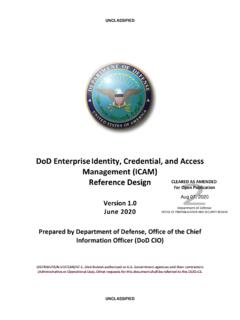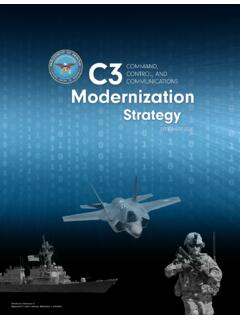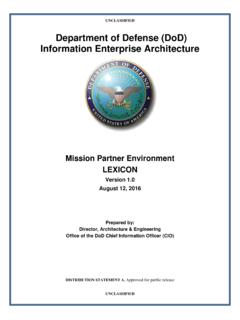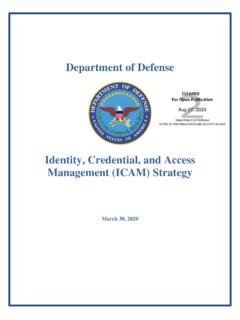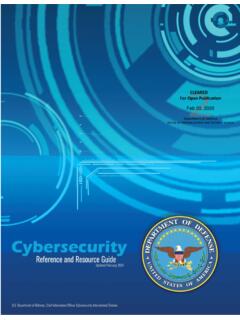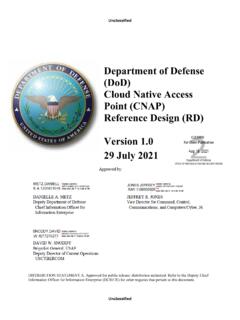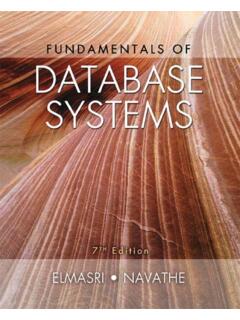Transcription of DevSecOps Fundmentals Guidebook
1 Unclassified UNCLASSIFIED CLEARED. For Open Publication Oct 19, 2021. Department of Defense OFFICE OF PREPUBLICATION AND SECURITY REVIEW. DevSecOps fundamentals Guidebook : DevSecOps Tools & Activities September 2021. Version This document automatically expires 1-year from publication date unless revised. DISTRIBUTION STATEMENT A. Approved for public release. Distribution is unlimited. 1. UNCLASSIFIED. Unclassified UNCLASSIFIED. Document Set Reference i UNCLASSIFIED. UNCLASSIFIED. Trademark Information Names, products, and services referenced within this document may be the trade names, trademarks, or service marks of their respective owners.
2 References to commercial vendors and their products or services are provided strictly as a convenience to our readers, and do not constitute or imply endorsement by the Department of any non-Federal entity, event, product, service, or enterprise. ii UNCLASSIFIED. UNCLASSIFIED. Contents 1 Introduction .. 1. Audience and Scope .. 1. 2 DevSecOps Tools and Activities .. 2. Security Tools & Activities Cross Reference .. 3. Plan Tools and Activities .. 5. Develop Tools and Activities ..10. Build Tools and Activities ..14. Test Tools and Activities.
3 17. Release & Deliver Tools and Activities ..23. Deploy Tools and Activities ..26. Virtual Machine Deployment ..26. Container Deployment ..26. Operate Tools and Activities ..29. Monitor Tools and Activities ..31. Configuration Management Tools and Activities Cross-Reference ..36. Figures Figure 1 DevSecOps Phases and Continuous Feedback Loops .. 1. iii UNCLASSIFIED. UNCLASSIFIED. Tables Table 1: Security Activities Summary and 3. Table 2 Specific Security Tools Common to All DevSecOps Reference Designs .. 4. Table 3: Plan Phase Tools.
4 6. Table 4: Plan Phase Activities .. 8. Table 5: Develop Phase Tools ..11. Table 6: Develop Phase Activities ..12. Table 7: Build Phase Tools ..15. Table 8: Build Phase Activities ..16. Table 9: Test Phase Tools ..18. Table 10: Test Phase Activities ..20. Table 11: Release and Deliver Phase Tools ..24. Table 12: Release and Deliver Phase Activities ..25. Table 13: Deploy Phase Tools ..27. Table 14: Deploy Phase Activities ..28. Table 15: Operate Phase Tools ..30. Table 16: Operate Phase Activities ..30. Table 17: Monitor Phase Tools.
5 32. Table 18: Monitor Phase Activities ..35. Table 19: Configuration Management Activities Summary and Cross-Reference ..37. iv UNCLASSIFIED. UNCLASSIFIED. 1 Introduction The goal of DevSecOps is to improve customer outcomes and mission value through the automation, monitoring, and application of security at every phase of the software lifecycle. Figure 1 DevSecOps Phases and Continuous Feedback Loops conveys the software lifecycle phases and continuous feedback loops. Figure 1 DevSecOps Phases and Continuous Feedback Loops Practicing DevSecOps requires an array of purpose-built tools and a wide range of activities that rely on those tools.
6 This document conveys the relationship between each DevSecOps phase, a taxonomy of supporting tools for a given phase, and the set of activities that occur at each phase cross-referenced to the tool(s) that support the specific activity. Audience and Scope The target audience for this document include: DoD Enterprise DevSecOps platform capability providers DoD DevSecOps teams DoD programs The Tools and Activities that follow are foundational, but incomplete when considered in isolation. Each DoD Enterprise DevSecOps Reference Architecture additively defines the complete set of Tools and Activities required to achieve a specific DevSecOps implementation.
7 1. UNCLASSIFIED. UNCLASSIFIED. 2 DevSecOps Tools and Activities The tools and activities that follow are common across all DevSecOps ecosystems. All Activities and Tools are listed in table format throughout this document. Tools tables identify specific categories of tooling required to support the proper operation of a software factory within a DevSecOps ecosystem. The tools captured are categorical, not specific commercial products and/or versions. Each program should identify and select tools that properly support their software development needs.
8 When possible, DoD enterprise-wide tooling that has already either been approved or has obtained provisional authorization is preferred. Tools tables include the below columns: Tool: A specific tool category Features: Common characteristics used to describe the tool category Benefits: Simple value-proposition of the tool category Inputs: Types of data collected by the tool category Outputs: Types of artifacts that result from using the tool category Baseline: Either a status of REQUIRED or PREFERRED, where required indicates that the tool must be available within the software factory as part of the Minimal Viable Product (MVP) release, and preferred indicates an aspirational capability obtained as the ecosystem matures Specific reference designs may elevate a specific tool from PREFERRED to REQUIRED, as well as add additional tools and/or activities that specifically support the nuances of a given reference design.
9 Reference designs cannot lower a tool listed in this document from required to preferred. Activity tables list a wide range of activities for DevSecOps practices. The activities captured here do not diminish the fact that each program should define their own unique processes, choose proper and meaningful activities, and select specific software factory tools suitable for their software development needs. The continuous process improvement that results from the DevSecOps continuous feedback loops and performance metrics aggregation should drive the increase of automation across each of these activities.
10 Activities tables include the below columns: Activities: Actions that occur within the specific DevSecOps phase Description: Simple explanation of the activity being performed Inputs: Types of data that feed the activity Outputs: Types of data that result from the activity Tool Dependencies: List of tool categories required to support the activity 2. UNCLASSIFIED. UNCLASSIFIED. Security Tools & Activities Cross Reference Security is integrated into the core of the DevSecOps phases, weaved into the fabric that touches each phase depicted in Figure 1 DevSecOps Phases and Continuous Feedback Loops.
